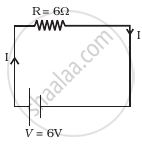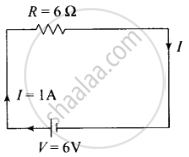Advertisements
Advertisements
Question
- Consider circuit in figure. How much energy is absorbed by electrons from the initial state of no current (ignore thermal motion) to the state of drift velocity?
- Electrons give up energy at the rate of RI2 per second to the thermal energy. What time scale would one associate with energy in problem (a)? n = no of electron/volume = 1029/m3, length of circuit = 10 cm, cross-section = A = (1mm)2

Solution
a. Relation between current and drift velocity is given by I = ne Avd, where vd is the drift speed of electrons and n is the number density of electrons.

According to the Ohm's law current in the circuit
I = V/R
I = 6 V/6 Ω = 1 A
But, I = ne Avd
or vd = `I/("ne A")`

On substituting the values,
For, n = number of electrons/volume = 1029/m3
Length of circuit = 10 cm, cross-section = A = (1 mm)2
`v_d = 1/(10^29 xx 16 xx 10^-19 xx 10^-6)`
= `1/1.6 xx 10^-4` m/s
Therefore, the energy absorbed in the form of KE is given by
Total KE = KE of 1 electron × no. of electrons
KE = `1/2 m_e v_d^2 xx n Al`
= `1/2 xx 9.1 xx 10^31 xx 1/2.56 xx 10^-8 xx 10^29 xx 10^-6 xx 10^-1`
= `2 xx 10^-17 J`
b. Ohmic loss (power loss) is `P = I^2R = 6 xx 1^2 = 6 W = 6 J/s`
Since, the energy dissipated per unit time is the power dissipated.
So, `P = E/t`
Therefore, `E = P xx t`
or `t = E/P = (2 xx 10^17)/6 = 10^17 s`
Important point: The energy dissipated per unit time is the power dissipated `P = (ΔW)/(Δt)`
The power across a resistor is P = I2R.
APPEARS IN
RELATED QUESTIONS
Estimate the average drift speed of conduction electrons in a copper wire of cross-sectional area 2·5 × 10−7 m2 carrying a current of 2·7 A. Assume the density of conduction electrons to be 9 × 1028 m−3
The number density of free electrons in a copper conductor is 8.5 × 1028 m−3. How long does an electron take to drift from one end of a wire 3.0 m long to its other end? The area of cross-section of the wire is 2.0 × 10−6 m2 and it is carrying a current of 3.0 A.
On the basis of electron drift, derive an expression for resistivity of a conductor in terms of number density of free electrons and relaxation time. On what factors does resistivity of a conductor depend?
At room temperature, copper has free electron density of 8.4 × 1028 per m3. The copper conductor has a cross-section of l0−6 m2 and carries a current of 5.4 A. The electron drift velocity in copper is:
The drift velocity of a free electron inside a conductor is ______
The relaxation time τ is nearly independent of applied E field whereas it changes significantly with temperature T. First fact is (in part) responsible for Ohm’s law whereas the second fact leads to variation of ρ with temperature. Elaborate why?
The potential difference applied across a given conductor is doubled. How will this affect (i) the mobility of electrons and (ii) the current density in the conductor? Justify your answers.
A potential difference (V) is applied across a conductor of length 'L' and cross-sectional area 'A'.
How will the drift velocity of electrons and the current density be affected if another identical conductor of the same material were connected in series with the first conductor? Justify your answers.
Two conductors, made of the same material have equal lengths but different cross-sectional areas A1 and A2 (A1 > A2). They are connected in parallel across a cell. Show that the drift velocities of electrons in two conductors are equal.
The drift velocity of electrons in a conductor connected to a battery is given by vd = `(−"eE" τ)/"m"`. Here, e is the charge of the electron, E is the electric field, τ is the average time between collisions and m is the mass of the electron.
Based on this, answer the following:
- How does the drift velocity change with a change in the potential difference across the conductor?
- A copper wire of length 'l' is connected to a source. If the copper wire is replaced by another copper wire of the same area of cross-section but of length '4l', how will the drift velocity change? Explain your answer.
